
Nicole Kurtz is our January 2017 Featured Artist
She is featured in the 2017 Mixed Roots Stories calendar.
In this interview, she shared with us her story, about the piece, and her current projects.
Visit Nicole’s website HERE to follow her work!

Nicole Kurtz is our January 2017 Featured Artist
She is featured in the 2017 Mixed Roots Stories calendar.
In this interview, she shared with us her story, about the piece, and her current projects.
Visit Nicole’s website HERE to follow her work!
Mixed Roots Stories Performance Sampler 2017
February 26th, 2:30 – 4:00 p.m.
At the 4th Critical Mixed Race Studies conference, four dynamic performers will share a sampling of their work followed by an open discussion with the artists on craft, process and engaging with themes of the mixed experience.
Elizabeth Chin and the Laboratory of Speculative Ethnology
The Jefferson-Hemings Complex
Elizabeth Chin is an ethnographer and anthropologist with a multifaceted practice that includes performative scholarship, collaborative research, and experimental writing. A professor at Art Center College of Design in the MFA program Media Design Practices/Field, she has published widely on children, consumption, anthropological practice. She has performed and done ethnography in the United States, Haiti, Uganda, and Cuba.
Gregory Diggs-Yang
Becoming Korean, While Growing Out My Afro: A Personal Narrative about a Moment in My Own Identity Development as a Mixed Korean and Black American
Gregory (Chan-wook) Diggs-Yang has a Bachelor’s (BA) in Education from Illinois State University and a Master’s (M.Ed.) in Educational Administration from UCLA. Greg has most recently moved from South Korea where he worked at Seoul National Universities as the Curriculum Coordinator for the IETTP (Teacher Training) and was a co-host of the Arirang Radio segment, ”Footprints of Korea with Chan-wook”. In addition he served as the President of the M.A.C.K. Foundation (Movement of the Advancement of Cultural-diversity of Koreans). A grassroots organization that supports multicultural schools and increases recognition and awareness of the diversity of Koreans. His areas of interest include multicultural education, mixed-heritage, and social justice. Greg is currently a doctoral candidate in the College of Education, Multicultural Education program at the University of Washington, Seattle. His dissertation looks at the support of biracial identity development through educational spaces.
Genevieve Erin O’Brien
Sugar Rebels
Genevieve Erin O’Brien is a Queer mixed race Vietnamese/Irish/German/
For additional conference programing and other details visit the CMRS website.
Mixed Roots Stories LIVE Performance 2017
February 25th, 6:00 – 7:30 p.m.
Mixed Roots Stories will open the 4th Critical Mixed Race Studies conference with live performances by the following:
 Robert Farid Karimi
Robert Farid Karimi
Disco Jesus – new work TBA!
Robert Farid Karimi is a community engagement specialist and comedic storyteller. He works with everyday people in cities, companies, and health centers worldwide on making healthy messaging delicious using comedy, culture and food with his culinary cultural engagement project: ThePeoplesCook Project. And, he speaks on issues as mixed race/consciousness, food politics, community deliciousness and the power of the Fool/Trickster to change the world. www.KaRRRimi.com
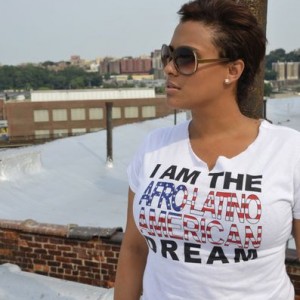 Crystal Shaniece Roman
Crystal Shaniece Roman
Black Latina the Play
In 2008 Ms. Roman launched The Black Latina Movement, LLC (BLM) and began performing BLM’s first written theatrical piece: a one woman show about the lives of dark-skinned Latinas and African American Latinas entitled Black Latina. In early 2013 Black Latina received a new format featuring an all female ensemble cast starring Judy Torres; during the fall the revamped Black Latina saw the success of multiple sold out shows. Since 2013 Black Latina the Play has been on tour in the Northeast at campuses such as: Hamilton College, Penn State University, Community College of Baltimore County-Essex and Lehigh University. Most recently Crystal revised the one woman version of Black Latina the Play after being invited to perform at the Smithsonian Institute for Hispanic Heritage Month Festival Latinidad- Looking into Latina Women’s American Experiences September 2016.
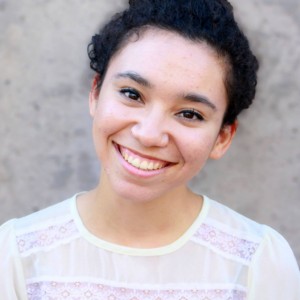 Carly Bates
Carly Bates
Musings of Rachel Dolezal
Carly Bates is an emerging artist from Phoenix, Arizona. With a background in music and piano performance, she is active in the Arizona arts community as a creative collaborator with musicians, movers, poets, actors: storytellers. Having recently graduated from Arizona State University, Carly is currently working with a local playback theatre company called Essential Theater and is also the editor for the Mixed Roots Stories Commons.
 Zavé Gayatri Martohardjono
Zavé Gayatri Martohardjono
Untitled (Balinese dance study)
Zavé Gayatri Martohardjono makes intercultural, geopolitical, boundary-defying, high glam performance, video, and installations. Interested in embodied risk-taking and cross-cultural imagery, they combine improvisation with their own cultural roots: Indonesian mythology and dance, queer iconography. Brooklyn based, Zavé has shown at Aljira Center for Contemporary Art, Boston Center for the Arts, Center for Performance Research, Center for Contemporary Arts in Glasgow, Leonard & Bina Ellen Art Gallery, Movement Research at Judson Church, Recess, SOMArts, Winslow Garage, among others. They have been an artist in residence at the Shandaken Project at Storm King, La MaMa Experimental Theatre, Chez Bushwick, and an Lambda Literary Emerging Writers Workshop Fellow.
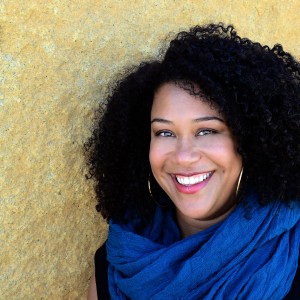 Lisa Marie Rollins
Lisa Marie Rollins
Performing an excerpt from SIDE CHICK: This ain’t no Harlequin Romance
Lisa Marie Rollins is playwright, poet, freelance director and dramaturg. Most recently she co-directed Young Jean Lee’s The Shipment (Crowded Fire Theater) and a reading of Tearrance Chisholm’s Br’er Cotton (Playwrights Foundation). She is the director of All Atheists are Muslimby Zahra Noorbakhsh and was co-producer of W. Kamau Bell’s “Ending Racism in About and Hour”. Lisa Marie performed her acclaimed solo play, Ungrateful Daughter: One Black Girl’s Story of Being Adopted by a White Family…That Aren’t Celebrities in festivals, universities and academic conferences across the US. She was Poet in Residence at June Jordan’s Poetry for the People at U.C. Berkeley, a CALLALOO Journal London Writing Workshop Fellow and an alumni in Poetry of VONA Writing Workshop. Her writing is published in Other Tongues: Mixed-Race Women Speak Out, River, Blood, Corn Literary Journal, Line/Break, As/Us Literary Journal,The Pacific Review and others. Currently, she is finishing her new manuscript of poems, Compass for which she received the 2016 Mary Tanenbaum Literary Award from SF Foundation. She is in development with her new play, Token. She holds degrees from The Claremont Graduate University and UC Berkeley. She is a Lecturer at St Mary’s College in Performance Studies, and a Resident Artist with Crowded Fire Theater in San Francisco. Lisa Marie is a 2015-16 playwright member of Just Theater Play Lab and Artist-in-Residence at BRAVA Theater for Women in San Francisco.
 Fred Sasaki EAT TO JAPANESE: Achieving ethnic authenticity by eating, shopping, emojis
Fred Sasaki EAT TO JAPANESE: Achieving ethnic authenticity by eating, shopping, emojis
A step-by-step guide to being genuine authentic
Fred Sasaki is the art director for Poetry magazine and a gallery curator for the Poetry Foundation. He is the author of Real Life Emails (Tiny Hardcore Press, 2017) and the zine series Fred Sasaki’s and Fred Sasaki’s Four-Pager Guide To: How to Fix You.
The Performance will be held at the Norris Cinema Theater 850 W 34th St, Los Angeles, CA 90089
This event is Co-Sponsored by the USC School of Cinematic Arts
Free tickets will be limited. Check back for a link to register.
For additional conference programing and other details visit the CMRS website.
Day of walk-ins will also be welcome pending ticket availability.
Mixed Roots Stories was honored to join MERGE students from Pomona College in preparing mentors for incoming students to the Claremont Colleges. The “Claremont Colleges” is a consortium comprised of 5 undergraduate colleges, and 2 graduate institutions in Claremont, California. MERGE (Multi Ethnic and Racial Group Experience) “is the Claremont Colleges’ club for multi-ethnic/multi-cultural students.” Their mission is “to provide a safe space for people of mixed heritage in which we may discuss issues of multi-racial and/or multi-ethnic identity and to raise awareness within the [Claremont Colleges] community.” Kaily Heitz, one of Mixed Roots Stories board members & Pitzer College alumna, is one of the founders of the organization.
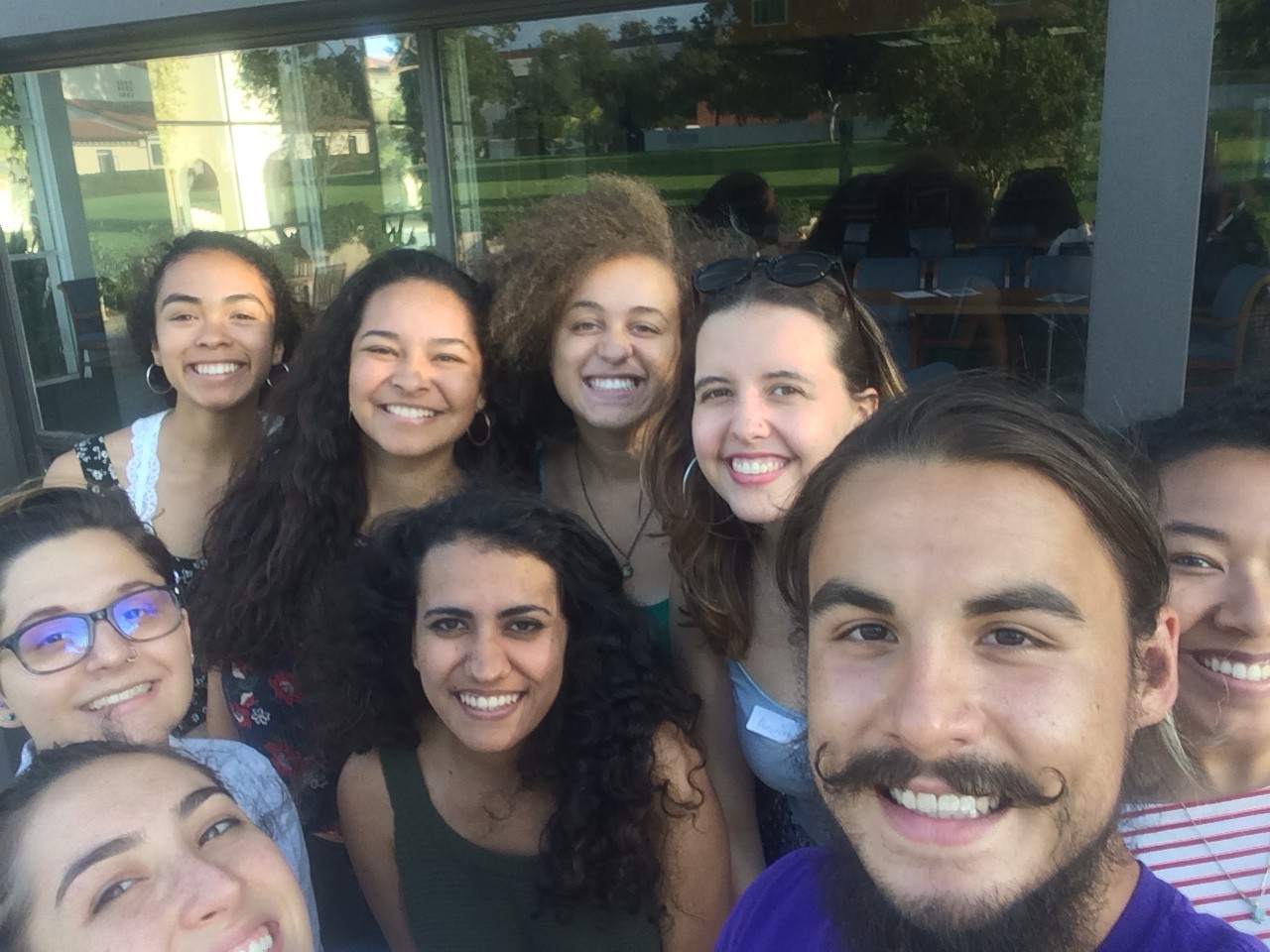
Dr. Chandra Crudup, also a Mixed Roots Stories board member, facilitated a workshop on Surviving Social Justice Fatigue through Diverse Storytelling. She led the group of students through defining social justice fatigue, identifying warning signs, and creating a survival guide. We then explored ways to creatively self care through sharing our individual and collective stories. The students were challenged to create an individual and/or group representation of who they are and what goals they have for MERGE. They decided to create a zine! Each student created one to four pages that will be compiled into a MERGE zine. The students shared their pages with the group describing what each element they included on their page represented or why they included it. It was an inspiring, encouraging, fun time! Check out the MERGE Zine in this video:
If you are interested in having a Mixed Roots Stories workshop work with your student group, email us at info@mixedrootsstories.org.
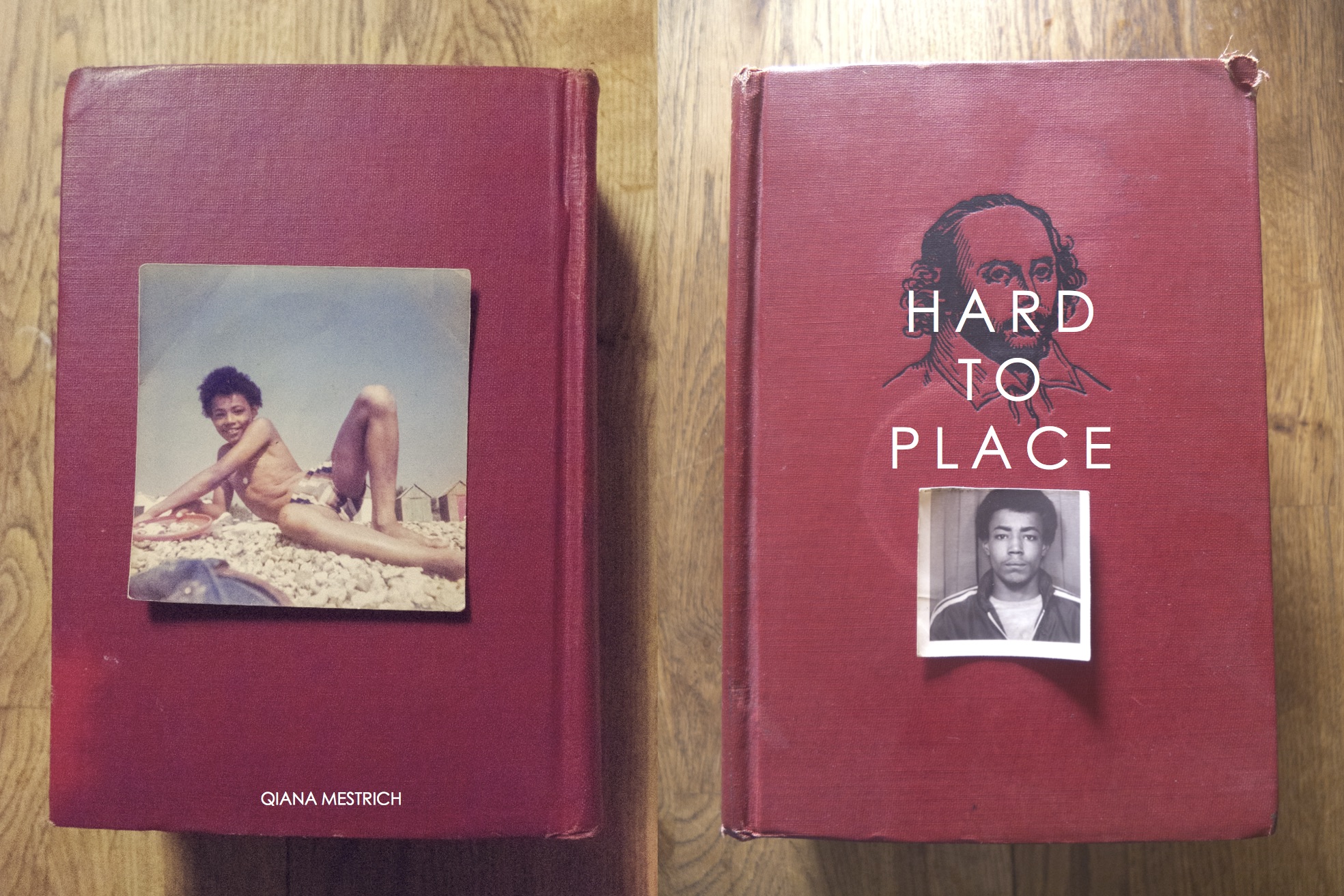
Featured Artist: Qiana Mestrich
Photographer | Writer
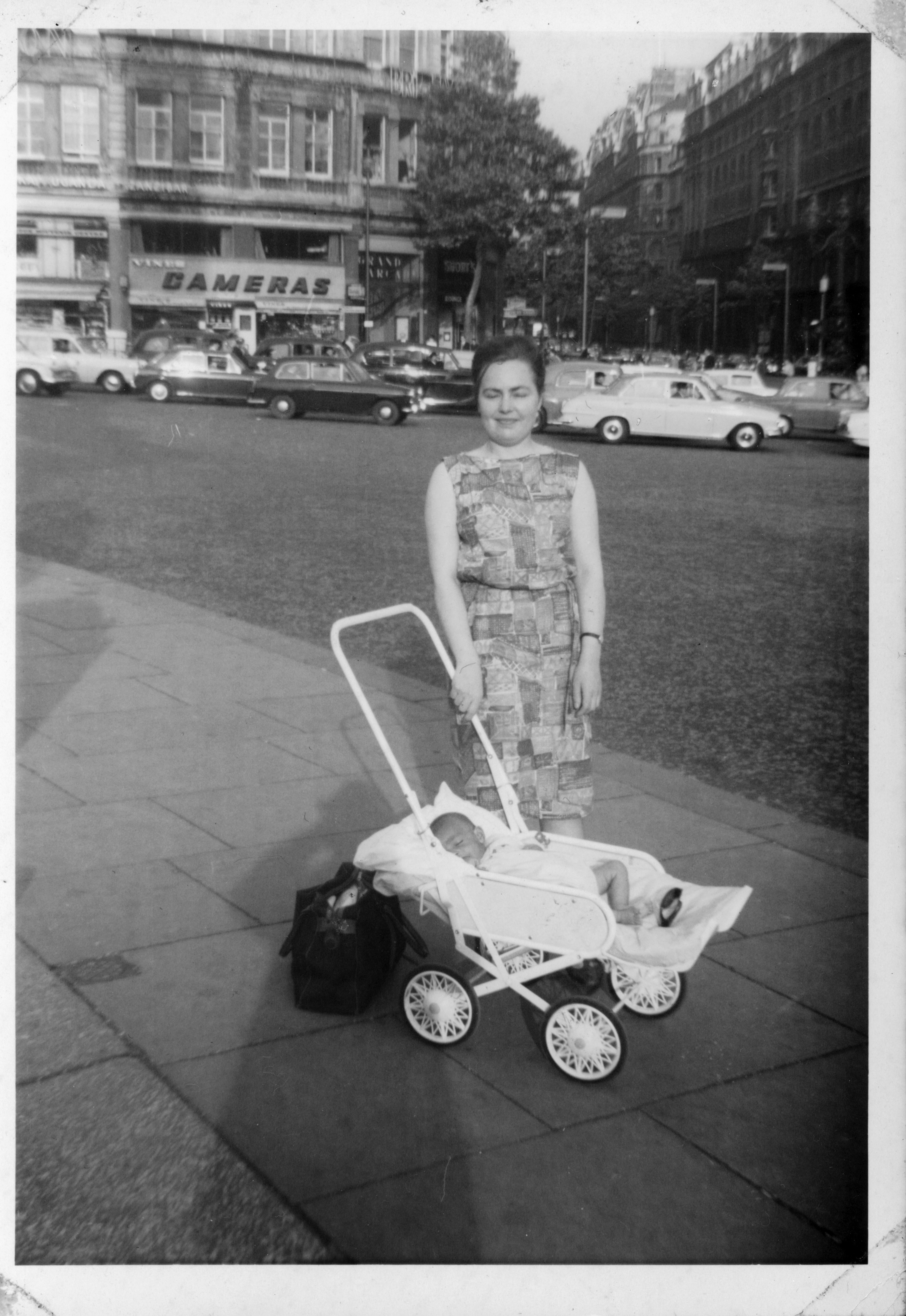
“Untitled (Maura and Joseph in Trafalgar Square), 1965” From the series Hard to Place (2016) Vintage photographic print
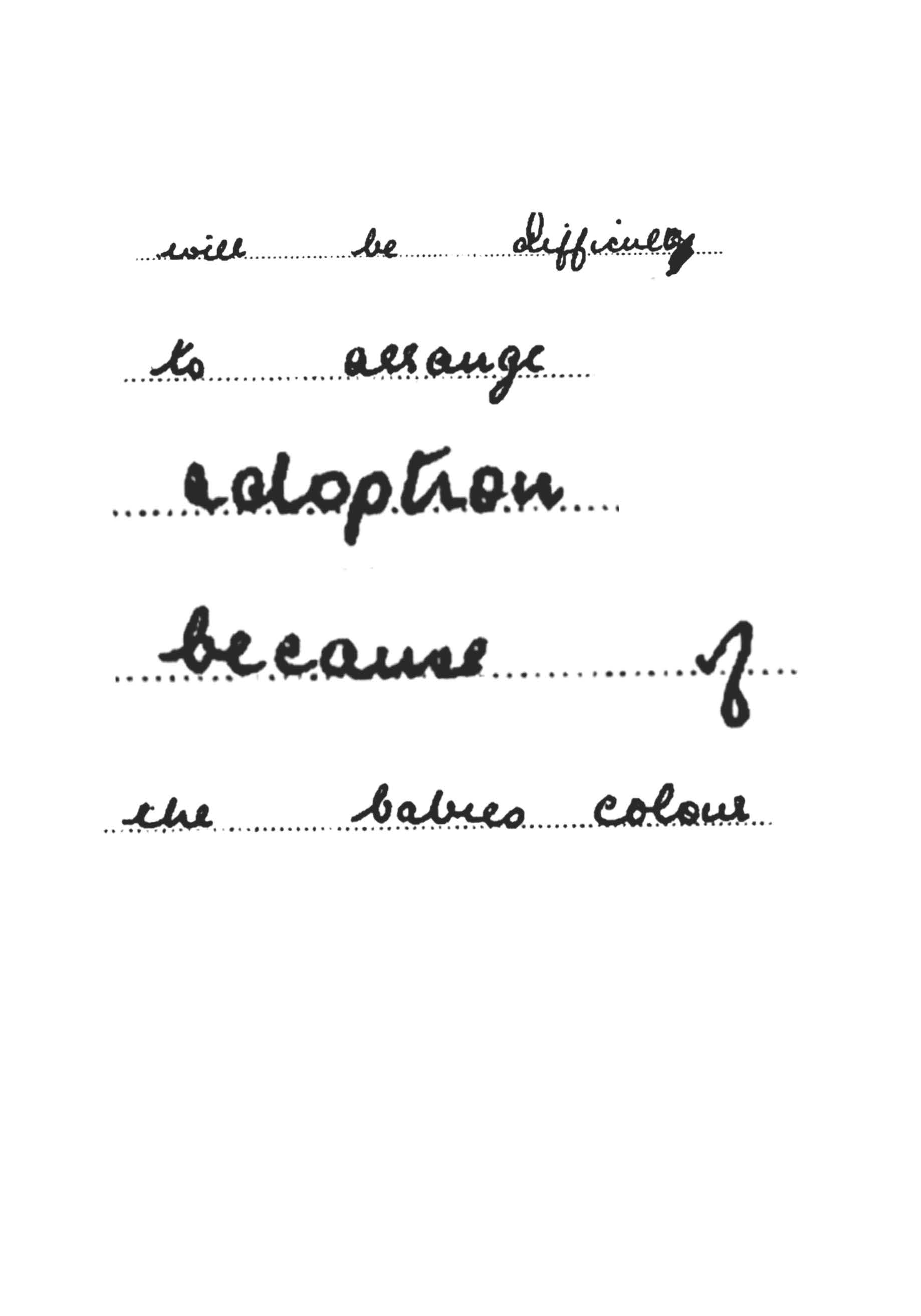
Page 42 from the book Hard to Place (2016)

“Untitled (Birthmark)” From the series Hard to Place (2016) Archival Pigment Print
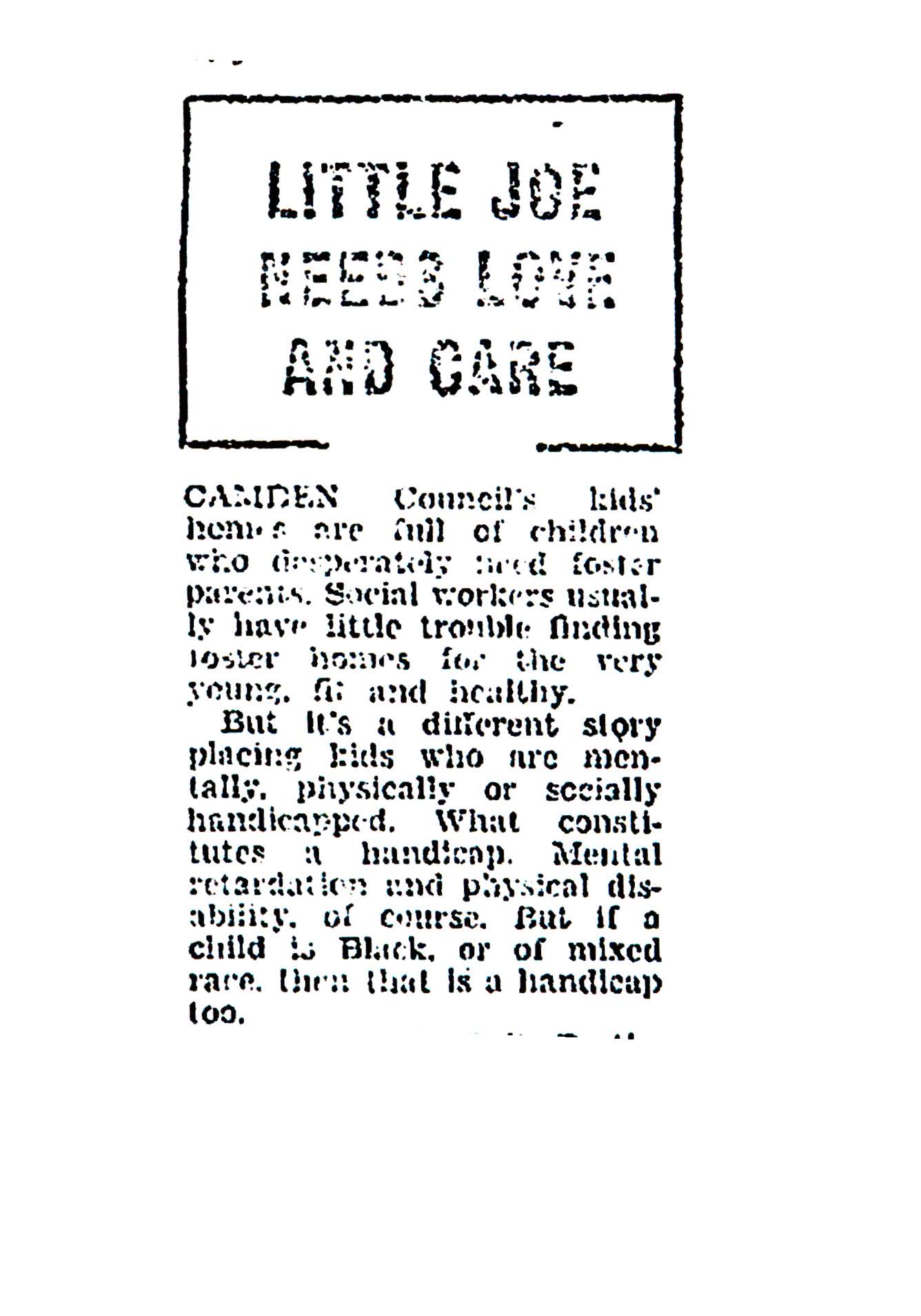
Page 46 from the book Hard to Place (2016) From the series Hard to Place (2016) Archival Pigment Print
Through still photography my work exposes hidden or denied histories, giving visibility to stories shaped by immigration, assimilation and the perceived failures of multiculturalism. I work primarily within documentary photography but have also employed archival photographs, texts and found digital imagery to create conceptual, constructed pieces.
My practice is research driven and I often use my own personal/family history as a place of reference because it is both what I know best and what I know little of. Driven by the Buddhist philosophy of interconnectedness by which I was raised, I make work because I don’t believe in coincidence. Always seeking to uncover seemingly tenuous connections, I believe the photographic image has the power to relate the personal with the universal.
My latest series, Hard to Place traces the journey of an orphan boy of Nigerian and Irish parentage growing up in 1960s/70s London. A “half-cast(e)” child in 1960s and ‘70s England, Joseph was considered “hard to place” amongst the mostly white, adoptive families. Consequently, Joseph was placed “in care” at eight different times from age three to seventeen.
Joseph is my husband, we met online in 2007. On our first date he nervously told me his lifestory, continuously pulling at his sleeves to hide the ink of bad decisions made during his teenage years as a black skinhead. That night he told me about how he was born in the UK to immigrant parents, eventually growing up in an orphanage located in the posh London neighborhood of Hampstead. We were both born on the 8th (of different months), both only children and we were both “mixed” with unanswered questions about our family origins…that night Joseph and I immediately connected and we’ve been together ever since.
As a wife, over the past six years I’ve witnessed Joseph become a father with little guidance and only an instinct of love. The little boy in the color, documentary images seen in Hard To Place is our son. As a photographer, my lens has captured tender and curious moments with my son and in these images he often becomes that precocious, yet lonely little boy I imagine his father was as a child. As a mother, I’ve developed the utmost compassion for Joseph’s mother and I can’t fathom the (inner and outer) struggles she endured as a single, Irish woman with a black child in a xenophobic and racist society.
Through the United Kingdom’s Data Protection Act of 1998, in 2013 Joseph Robert Cullen received two legal-sized books stuffed with photocopied files documenting the years he spent as an orphan. The documents include typed and handwritten text written by social workers observing both Joseph and his mother Maura aka Maureen who often needed financial and housing assistance. Combining confidential government documentation, archival photographs, personal possessions and documentary images, this series reveals the social and moral forces that denied Joseph his birthright to a family while imagining an alternate (albeit uncertain) narrative. This series includes photographic, archival material and other possessions belonging to Joseph’s parents which he inherited after their passing. The inclusion of these personal archives counters the inherent definition of the orphan child as someone who comes from nothing and no one.
The dominant narrative of mixed-race orphans is that they are all born of wars, the product of illicit love affairs (or rapes) between women and the soldiers that occupied their countries. Some popular examples of these “occupation babies” include those born during/post World War II in Japan and the Korean War. It’s interesting to note that although white soldiers fathered children (often at higher rates), the offspring of black soldiers were far more ostracized.
A relationship between two people is fostered and sustained not only by the love that each person has for one another, but by the support it receives from their community and others outside their union. Even the general social sentiment plays a role in validating their union, allowing for such simple pleasures yet symbolic gestures such as holding hands in public.
I’ve self published Hard To Place as a photography book and the first spread features a portrait of Joseph’s father on the left and his mother on the right. The reason why I chose the book form to represent this series is in relation to the family album or scrapbook, mediums meant to preserve memories. For me this pairing of parents was important to create as it is a familiar photograph found in family albums.
This coupling, preserved in photographic emulsion, has been a constant in the history of the medium. So much so that people who’ve been raised by both parents often take this kind of photograph for granted not realizing how many people worldwide do not have this visual affirmation of the love that created them. I don’t know why Joseph’s parents were never photographed together, but I do recognize the power of this formal arrangement (specifically in the shaping of a mixed-race identity) and have even replicated it on the walls of our home.
The orphan is a common human archetype. There have been many notable celebrities, world leaders, figures within classical history and religious scripture, in literature and even comic book heroes who began life as orphans. Yet there has been very little within popular culture, international news or the arts about ordinary children made orphan because of the strain of historical and everyday racist attitudes. We don’t often hear of the children abandoned by one or both parents because of the stress of discrimination from society and often their respective family members that has fractured their unions.
Alone and marginalized, these children bear the intolerable weight of their parent’s failed love and that of mankind’s dark, unsettled history with race. I’m not sure which hurts worse.
Questions for Further Consideration
Additional Reading
Essay on Hard To Place by writer Paula Kupfer
http://booklyn.org/events/qiana-mestrich-hard-to-place/
RESPONSE
Assemblages convey stories through their grouping and positioning of objects, and Qiana Mestrich’s work Hard to Place weaves the narrative of her husband’s past, present, and future through the lens of acute observation and love. The title, Hard to Place, references the difficulty of placing Joseph in adoption because of his mixed heritage, but also the title alludes to the physical ambiguity of the multiracial body. “What are you?” is a frequent question a mixed body hears because the ways our bodies present themselves make us hard to place as well. What struck me was the speculative elements of Mestrich’s piece, particularly how the piece fill the gaps where Joseph’s story is unclear. Through imagining a holistic narrative, the places where Joseph’s family story is incomplete is filled in with abstractions and the beauty of the everyday and mundane. The quotidian elements of Hard to Place show how Joseph’s story is at the same time very unique and quite ordinary.
-Dr. Alexandrina Agloro
Dr. Alexandrina Agloro is a game designer, community-based researcher, and media artist who believes in the possibilities of the decolonial imaginary using digital media as an emancipatory tool. She is an Assistant Professor of Interactive Media and Game Development at Worcester Polytechnic Institute. Find more about her work at http://agloro.org.

Sharon H. Chang’s inaugural book, Raising Mixed Race: Multiracial Asian Children in a Post Racial World, lays out a blue print that outlines the history of white supremacy and how it has corrupted the way people treat each other, specifically Mixed Race/ Multiracial and Multiracial Asian individuals. She develops an important foundation that provides a glimmer of hope for moving forward toward improving our future world, despite the powerful suppressive system before us.
The title might make you think it is a parenting book, and it is (or could be), but it so much more! The language/verbiage used in the book makes this potentially academic/research strong book accessible for those who might have the most questions…parents. Though this book has a focus on multiracial Asian children, it is not just a book for parents of multiracial Asian children. It is a book for all children of color…and even for parents of white children! This book is for anyone who comes in contact with children in any way. This means if you are a teacher/educator, a child care worker, do research with children or on race and intersectionaility…or if you are a parent, sibling, aunt, uncle, grandparent, or once was a child. This book is for everyone!
The book is based on Chang’s interviews with 68 parents of 75 young children living in Washington State. She does not go into detail about her recruitment and method, however she does discuss this in my recent interview with her (see Part 1 of 2 below). She intertwines her findings with current and historical events, existing scholarly research and reports, her expertise in tracking dialogue across social media, her own multiracial Asian experience and more.
The focus is on children from 0 to 5 years old. This is an age that has been neglected in most parenting books and research with a multiracial focus. This is also an age during which many parents think that their children do not recognize/see race; however Chang shows us that they absolutely do. Young children are learning from the subtle and often unspoken systematic racism that is infused throughout every aspect of our society.
Chang makes it clear that the understanding of race begins in the home. In a world that is fearful to discuss how white supremacy has been engrained into society and families generation after generation…it is time families start having these difficult conversations. Chang warns that race is not easy to discuss, but essential and does not have to be done alone. It can be done through community. Her last chapter provides specific examples of how to address race in the community, school, and home.
This is the first book that I have seen, that looks at racial identity development, and puts systematic racism and white supremacy where it belongs…. at the beginning and linked over and over again to the end. To understand and address race issues with our children, we must begin with its origin story. When attempting to comprehend the lens in which race issues are created, we must understand the frame in which that lens is held together – white supremacy. Chang tells it like it is. She lifts the curtain on age-old white ideas of race, breaks down history, language and concepts that have created divisions between people who look different or do not follow the prescribed norms. For example, she breaks down how the trending term microagression was created from a white lens and points out there is nothing small or mirco about them! She deconstructs terms used in medical spaces, such as “Mongolian Spots” that have racist origins; and many individuals have just come to believe that is what they are called (See Part 2 of 2 below for more on this). Additionally, she provides a fantastic response to the common question/idea “But aren’t we all mixed?” in one of the most eloquently written explanations I have seen. Watch Part 2 of 2 below to hear about how she responds to the question and her new elevator response to this question!
The book is coming out just in time for the holidays, and will make a great gift. It should be on everyone’s 2016 reading list! You can order the book on the publisher site or on Amazon.
Be sure to join Sharon on December 11th for her Facebook launch party. She will be partying all day and giving away some great prizes. Don’t miss it!
You can find the Multiracial Asian Families community and blog page on Facebook, the book page on Facebook. You can fin her on Twitter @mutliasianfams, Pinterest, or on her blog MultiAsian Families.
Watch my recent interview with Sharon!
Part 1 – She shares her mixed roots story, how the book came to be and more!
Part 2 -We discuss content from the book including: “Mongolian spots”, miss-education and the need for reeducation around racist terms, how to respond to -“Everybody is Mixed”, Culture vs. Race, Anti-bias curricula, learning environments and more.
Chandra Crudup, PhD, MSW is a board member and co-founder of Mixed Roots Stories. She is the Vice President of MAVIN and the Production Manager for One Drop of Love. Chandra is full time Lecturer and Faculty Associate Coordinator in the School of Social Work at Arizona State University. She has over six years of practice experience in K-12 schools. Her research interests are centered on multiracial identity and interracial relationships. Her research utilizes video technology as a qualitative data gathering tool. She is also interested in using the arts as a medium to build positive self-esteem in youth.
Podcast: Play in new window | Download
Audio clip: Adobe Flash Player (version 9 or above) is required to play this audio clip. Download the latest version here. You also need to have JavaScript enabled in your browser.
Jenina Gallaway recently joined us for a MXRS Podcast – Telling the Story Behind the Stories. You can follow her on her Facebook page http://www.facebook.com/
Soprano, Jenina Gallaway, has performed internationally and throughout the United States in a wide range of genres. Operatic repertoire includes: Rosalinda in Die Fledermaus, Vitellia in La clemenza di Tito, the title role in Suor Angelica, Serena in Porgy and Bess, Anna Maurrant in Street Scene, Mrs. Augusta Tabor in The Ballad of Baby Doe, and the Sorceress in Dido and Aeneas.
Equally committed to the concert repertory, Gallaway has performed as the soprano soloist in Anton Bruckner’s Te Deum, Beethoven’s Ninth Syphony, Dvořák’s Te Deum, and Brahms’ Neue Liebeslieder, among others.
A recipient of several awards, Gallaway was an Arizona District Winner and Western Region Finalist in the Metropolitan Opera National Council Auditions where she received an encouragement award. She has also been a finalist in the Palm Springs Opera Guild Vocal Competition. In Tucson, Gallaway has been a first place winner in several competitions including the Ameilia Reiman Vocal Competition, Marguerite Ough Vocal Competition, and the Opera Guild of Southern Arizona’s Quest for the Best Vocal Competition. She has also received awards from the Opera Buffs, inc., Fe Bland Foundation Music Award, Society of Singers and the Village Voices Chorale.
Born and raised in Californina, Gallaway holds a Masters in Vocal Performance from California State University, Northridge, a Bachelors in Vocal Performance from Azusa Pacific University, and is currently working towards a DMA in Vocal Performance at the University of Arizona.
Happy Memorial Day Weekend Friends and Followers!
This weekend the MXRS team got together in preparation for our commemoration of Loving Day 2015: Visualizing Loving Day. This year we thought it would be fun to celebrate the radical love of Richard and Mildred Loving, as well as the pivotal Supreme Court Ruling allowing interracial couples to marry by creating a mixed-media collage. Check out what we did and share your own Visualizing Loving Day projects, activities, and stories!
Materials:
Printed Copy of The Loving’s Story (Print story from www.lovingday.org : here)
Small Canvas
1 Pack of Sticker Numbers & Letters
1 Tube of Paint in a Color of Your Choice (acrylic works best, but tempora will work too!)
Sponge brush or old dish sponge
Decoupage or Mod-Podge
Glue Stick
Scissors
Old Magazine
How to:
Step 1: Read the Loving’s Story. If you are doing the project with friends and family members, discuss what this story means for you and why learning their story is important. If you are doing the project with children consider “The Case for Loving: The Fight for Interracial Marriage” by Selina Alko.
Step 2: Cut or tear images, colors, interesting words, and/or textures from the magazine. Collage pieces together with quotes from the Loving’s story and adhere to your canvas using the glue stick. TIP: Concentrate color and meaningful text in the center of the canvas. Bright colors and unique textures work best.
Step 3: Once you are satisfied with your collage, use the Mod-Podge to seal your design. Let this dry completely (at least 20 minutes).
Step 4: Once your collage has dried use the sticker letters to spell “Loving 1967,” or “Loving Day 1967”.
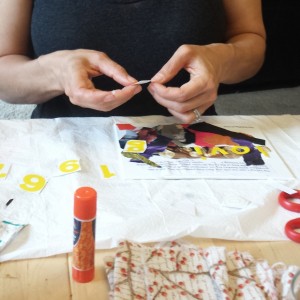
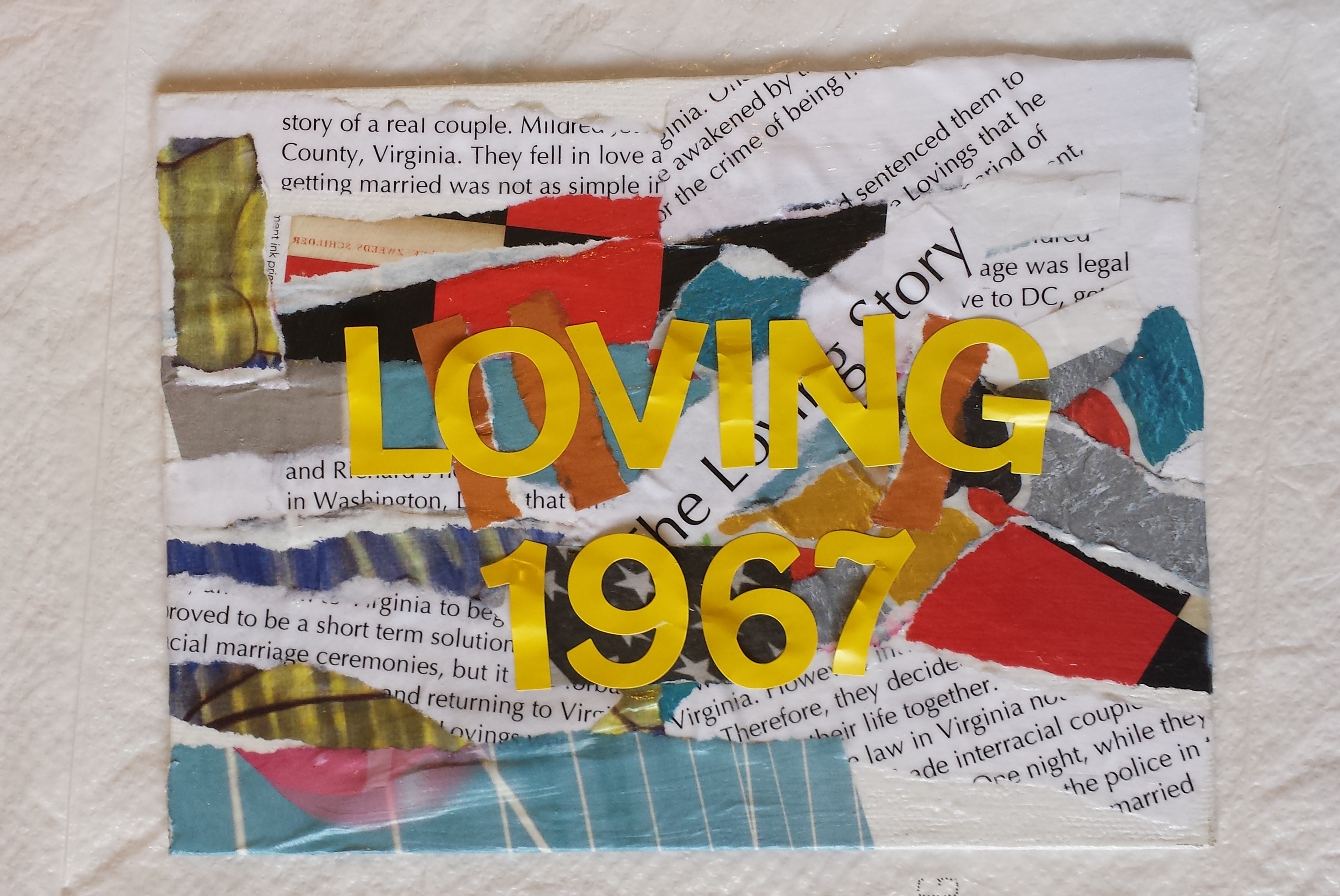
After the stickers are secured to your collage in a place of your choosing, use sponge to dab paint over your collage, covering the letters completely. Let dry.
Step 5: After the paint has completely dried, carefully peel the letters off of the canvas.
That’s it! Now display your collage momento for friends, family, and guests to see in order to continue the conversation year round!
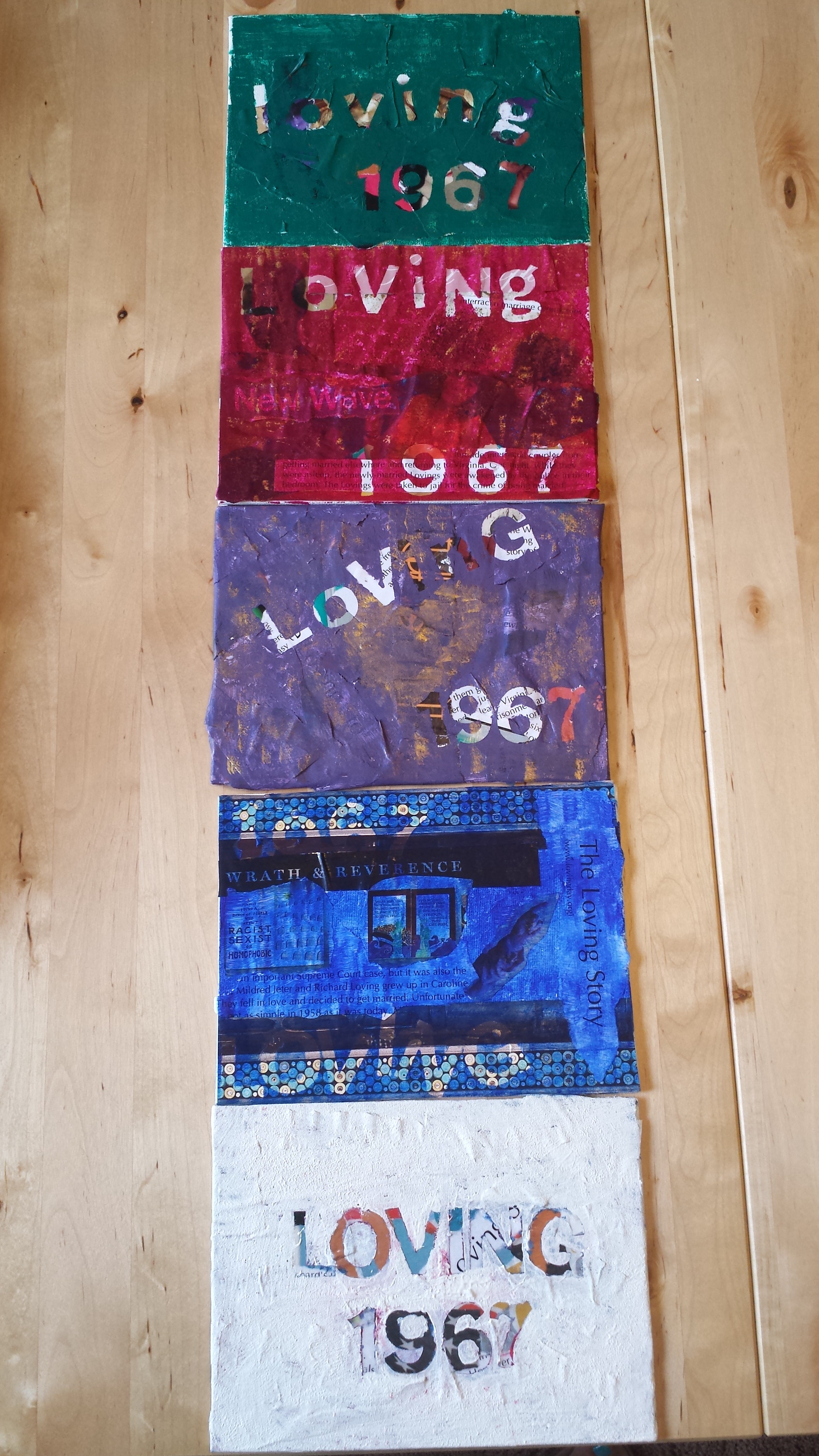
Happy Loving Day from MXRS!
Be sure to send us pictures of your Loving Day Mixed Media Collages!
Do you binge watch shows and movies online? We do! We found these 6 programs on Netflix that feature mixed roots discussions. Check them out, critically discuss them with others, and learn more! We have provided some questions to consider while watching each one, as well as further reading/resources to keep you thinking and critically looking at mixed roots stories!
We are just getting started with our Netflix recommendations, and we’d love your contributions. What films/TV series have you seen that are relevant? What critical questions can we explore when/after watching them? What mixed identity groups aren’t represented here? Send us an email to info@mixedrootsstories.org.
From Trevor Noah:
Trevor Noah brings to film his unique brand of observational humor born of his mixed-race experience under the South African apartheid system. In his most recent stand-up special Trevor weaves together compelling stories with wicked smart observations on the inanity of the racial construct in the United States. The theme of Trevor’s presentation is his journey to America, because he believes he can be fully black here. A clip from Gabriel Iglesias StandUp Revolution:
Mixed Roots Stories Questions to consider while watching:
1) Can humor be an effective storytelling tool for change, especially on matters of race, culture and ethnicity?
2) As you watch Trevor Noah: African American, do you think his point-of-view effectively challenges our racial assumptions?
3) How does idea of mixed/blackness transfer between countries?
4) What does it mean to be “fully black?”
For Further reading/discussion:
Nancy Goldman makes an argument in her paper that humor can be a powerful tool for social change – Comedy and Democracy: The Role of Humor in Social Justice.
From abcfamily.go.com/shows/the-fosters:
The Fosters is a one-hour drama about a multi-ethnic family mix of foster and biological kids being raised by two moms. Stef and her partner Lina have built a close-knit , loving family with Stef’s biological son from a previous marriage, Brandon, and their adopted twins Mariana and Jesus. But how will things change when they meet troubled teen Callie and her little brother Jude?
Mixed Roots Stories Questions to consider while watching:
1) What responsibilities do parents raising kids from different cultures than themselves have in teaching their children about those cultures?
2) Lina identifies as biracial – how does this affect her relationship with her partner, Stef, and her children? Do the conversations she has with her African American mother surprise you, or not? Why?
For Further reading/discussion:
Lisa Marie Rollins is a TRA (TransRacial Adoption) Activist. Her blog, poetry and live performance provide lots of insight into the TRA experience. Learn more here: https://birthproject.wordpress.com/
From lovingfilm.com:
The Loving Story, a documentary film, tells the story of Richard and Mildred Loving to examine the drama, the history, and the current state of interracial marriage and tolerance in the United States.
Mixed Roots Stories Questions to consider while watching:
1) What do you think were the most compelling arguments made by the Loving’s legal team to persuade the Court to rule in their favor?
2) What are some of the other Supreme Court decisions that have had a strong impact on the mixed community?
For Further reading/discussion:
For a more in-depth analysis on Loving v. Virginia and the people involved, see Race, Sex and the Freedom to Marry by Peter Wallenstein (mixedracestudies.org).
NBC recently aired the final season (season 6) of Parenthood. You can catch up/re-watch the first 5 seasons on Netflix. “Parenthood bravely and delicately take on the complexities of family life leaving viewers full of emotion after every episode like all good comedy/drama stories should! In addition to other major topics (cancer, post traumatic stress disorder and more), this series follows an interracial marriage and their child, the process of a transracial adoption and has explored an interracial teenage dating situation.” (https://mixedrootsstories.com/parenthood/)
A few key seasons/episodes:
Season 2 – Crosby and Jasmine (an interracial couple) are trying to figure out how to raise their child and if they are going to work on their relationship or continue to be separated. Addie begins dating Alex, and her parents begin to question the relationship, pushing her to move in with her grandparents. But are they questioning it because he is a different race or because he has a history of substance abuse?
Season 3 – Crosby and Jasmine work out their differences. Julia and Joel interracially adopt a son.
Season 4 – Crosby and Jasmine have a discussion with their son about race (Episode 4). Julia and Joel take on the challenge of raising their adopted son.
Season 5 – Crosby and Jasmine expand their family with a new baby girl. Jasmine’s mother has ideas of how religion should play a role in the families life.
Mixed Roots Stories Questions to consider while watching:
1) If your child brings home a partner with a mixed background (different race, culture, religion, gender orientation, country of origin, etc.) than what you expected, would you be concerned? Why? Would you voice your concern? How?
2) In Season 4 Episode 4 Crosby realizes there are situations his mixed race son will have to deal with that he won’t be able to protect his son from. How would you or do you answer these/similar questions?
For Further Reading/Discussion:
Raising Biracial Children by Kerry Ann Rockquemore & Tracey Laszloffy, takes on identity development with mixed-race individuals within a historical context and creates a framework to assist parents, educators, social workers, counselors and anyone who works with multiracial individuals.
Donna Jackson Nakazawa wrote Does Anybody Else Look Like Me: A Parent’s Guide to Raising Multiracial Children out of frustration in a bookstore, when she was unable to find a book that provided guidance on how to address the situations she was facing in her mixed roots family.
The appendix of both books have lists of useful resources!
Set in 1930, western Australia, Rabbit Proof Fence tells the true-life story of two “half-caste” girls who were taken from their families, by the government, and placed in a camp where they are trained to be servants for white families. The hope is for these children to end up marrying white Australian men so their aboriginal blood can be bred out. The girls escape and take off on a journey to find their family.
Mixed Roots Stories Questions to consider:
1) The United States is not the only country that has had a history of hiding unspeakable events around race/color differences. What value, if any comes, from being aware of a global mixed roots history?
2) In what ways do institutions continue to support and enforce the separation of different people?
For Further Reading/Discussion:
“My Place” by Sally Morgan
“Daughter Dies With Her Story Still Incomplete”
In this PBS 4 episode series, “Prof. Henry Louis Gates Jr. Discusses the massive influence of African ancestry on the history and culture of Latin America and Caribbean.” He goes to: Mexico, Peru, Brazil, Cuba, Haiti, and the Dominican Republic.
Mixed Roots Stories Questions to consider:
1) As Gates interviews each country, how does his North American views of “Black” influence his questions, interactions, and expectations on what answers he is looking for in South America?
2) Both North and South America have a history of slavery with “Black” or African people. How are these histories similar and/or different? What lessons can be gleaned from both continents mixed roots histories?
For Further Reading/Discussion:
“Black In Latin America” by Henry Louis Gate Jr. http://www.mixedracestudies.org/wordpress/?p=31565
“Latining America: Black-Brown Passages and the Coloring of Latino/a Studies by Claudia Milian
http://www.mixedracestudies.org/wordpress/?p=25463
Call for Guest Bloggers:
